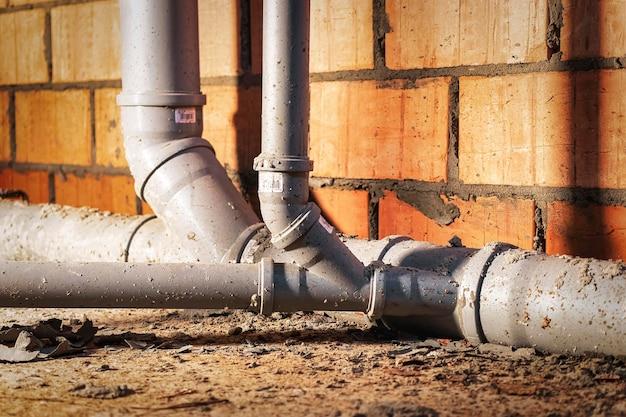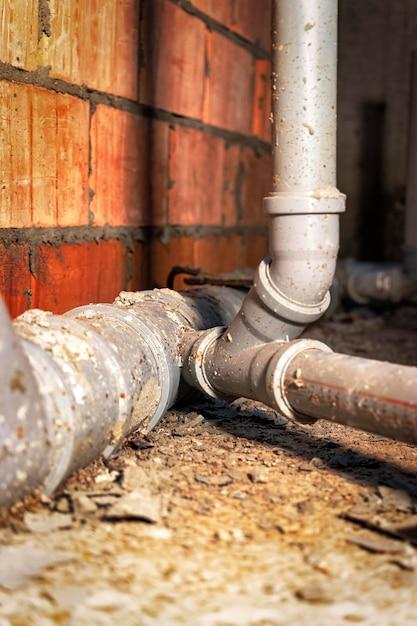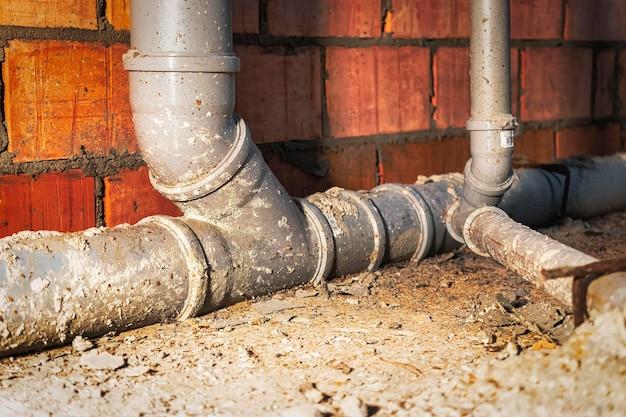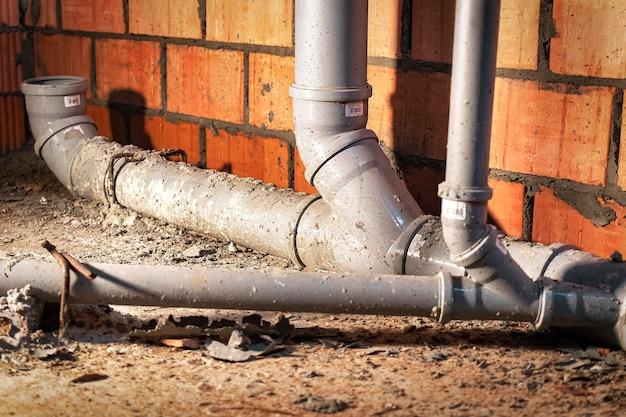Have you ever experienced the unpleasant surprise of seeing sewage flowing back into your basement through the floor drain, toilet, or shower? If you have, you know how messy, smelly, and hazardous this situation can be. Sewage backup in the basement is not only disgusting but also poses serious health risks to you and your family. Bacteria, viruses, parasites, and other pathogens present in raw sewage can cause diseases like E.coli, hepatitis, and salmonella. In this blog post, we’ll explore the causes, risks, and solutions of sewage backing up into the basement, and provide you with practical tips on how to deal with this nasty problem.
What Causes Sewage Backup in Basement
Several factors can contribute to sewer backup in the basement. One of the most common causes is a clogged or overloaded sewer line. When the main sewer line that connects your home to the municipal sewer system gets blocked by tree roots, grease, or other debris, the sewage has nowhere to go but back into your basement. Another cause of sewer backup in the basement is a malfunctioning sump pump or a failed check valve. If your sump pump fails to discharge the groundwater from your basement, or if the check valve doesn’t prevent the backflow of sewage, you’re at risk of basement flooding and sewage backup.
What Are the Risks of Sewer Backup in Basement
Apart from the foul smell and the unsightly mess, sewage backup in the basement can pose serious health risks to you and your loved ones. Raw sewage contains harmful pathogens that can cause illnesses, infections, and respiratory problems. Exposure to sewage fumes can trigger symptoms like nausea, vomiting, headaches, and dizziness. Moreover, sewage backup can damage your property and belongings, leading to costly repairs and replacements.
What Should You Do If Sewage Backs up in Basement
If you notice sewage backing up into your basement, you should act promptly to prevent further damage and contamination. First, turn off the electricity and gas in your basement to avoid electrical shocks and gas leaks. Then, open the windows and doors to ventilate the area and reduce the odor. Don’t attempt to clean up the sewage on your own, as it’s hazardous and requires specialized equipment and expertise. Instead, call a professional sewage backup cleanup company to handle the job safely and effectively.
Sewage backup in the basement is a messy, smelly, and dangerous situation that requires immediate attention and action. By understanding the causes, risks, and solutions of this problem, you can protect your home and family from the harmful effects of raw sewage. Remember to always stay safe and call a professional for help when dealing with sewer backup in the basement.
Sewage Backing Up into Basement: Causes and Solutions
Are you tired of experiencing sewage backup in your basement? It’s not only an unpleasant sight, but it can pose serious health hazards to you and your family. In this section, we’ll examine the causes of sewage backup and suggest some solutions to help you prevent it from occurring.
Common Causes of Sewage Backup into Basement
Clogs in the Main Sewer Line
One of the most common causes of sewage backup is clogs in the main sewer line. When the main sewer line gets clogged, sewage can flow back into your basement. Tree roots, debris, or other foreign objects can cause clogs in the main sewer line.
Blocked Sewer Lateral Pipe
The sewer lateral pipe connects your house’s plumbing system to the municipal sewer system. When there’s a blockage in the sewer lateral pipe, sewage can back up into your basement. Blockages can be caused by tree roots, grease buildup, or even misplaced objects flushed down your toilet.
Heavy Rainfall
During heavy rainfall, the sewage system can become overwhelmed, leading to sewage backup. This is especially true if your area has an outdated sewer system.
Solutions for Sewage Backup into Basement
Install Backwater Valves
Backwater valves are designed to prevent sewage from flowing back into your house. These valves are installed in your basement floor and automatically close when sewage backs up.
Maintain Your Plumbing System
Regular maintenance of your plumbing system is crucial in preventing sewage backup. Inspect your sewer lateral pipe frequently, and clear any blockages as necessary.
Install a Sump Pump
A sump pump can help to prevent sewage backup by diverting water away from your basement. It’s especially useful during heavy rainfall.
Call in Professionals
If you’re experiencing frequent sewage backup into your basement, it’s time to call in professionals. They will perform a thorough inspection of your plumbing system and recommend the best solution to prevent further sewage backup.
In conclusion, sewage backup into basement is a serious issue that requires urgent attention. By understanding the common causes and implementing preventative measures, you can avoid this unpleasant and hazardous situation.
Sewer Backup Cleanup
Dealing with sewage backups is not an easy feat. Not only is it a smelly and messy job, but it’s also hazardous to your health. That’s why it’s essential to prioritize safety when cleaning up sewer backups in your basement.
Safety First
The first step to sewer backup cleanup is to ensure safety. Wear protective gear and clothing that covers your skin entirely, including gloves, boots, and goggles. Avoid touching any sewage material with your bare hands, and ensure that the area is well-ventilated.
Tools You Need
Next, equip yourself with the necessary tools for sewer backup clean up. You will need a wet vacuum, mops, buckets, garbage bags, and disinfectants. Ensure that these tools are separate from those you use for other house chores.
DIY or Professional Help
In most cases, sewer backup cleanup is a job you can do as a DIY project. However, if the sewage backup is extensive, and you’re not sure of yourself, it’s best to hire professional cleaners. They have the necessary experience, tools, and protective gear to discharge the task safely and efficiently.
Disinfecting the Area
Once you clear all the sewage backup, it’s time to disinfect the area. Use a disinfectant to clean the entire basement space thoroughly. Be careful not to damage any property or belongings in the basement.
Preventing Future Backups
Preventing sewage backups in the future is essential to avoid a recurring problem. One way to do this is to install a backwater valve and have regular sewer line inspections. Always ensure that you’re not flushing anything down the drain that could clog the sewer line.
Sewer backup cleanup is one of the dirtiest jobs you’ll ever do, but with these tips, you can do it safely and efficiently. Remember to prioritize safety, use the correct tools, and disinfect the area to avoid bacterial infections. Then, consider implementing preventative measures to avoid future backups.
Sewage Backup in Basement Health Risks
If you have ever experienced sewage backup in your basement, you know how unpleasant the experience can be. Besides the foul odor, it can pose several health risks to you and your loved ones. Here are some of the health hazards you may face because of this unpleasant experience:
Respiratory Illnesses
One of the significant health risks associated with sewage backup in the basement is respiratory illnesses. The sewage water contains bacteria, viruses, and other microbes that can cause respiratory ailments such as allergies, asthma, and other infections.
Skin Irritation
Sewage water contains several chemicals and bacteria that can cause skin irritation and rashes. Exposure to raw sewage can cause inflammation or irritation of the skin, which can lead to itching, soreness, or redness.
Gastrointestinal Issues
Sewage water contains harmful bacteria and viruses that can cause diarrhea, vomiting, and other gastrointestinal problems. If you have any underlying health conditions, this can cause serious health issues and even hospitalization.
Accidents and Injuries
Sewage backup can also lead to accidents and injuries in your basement. Raw sewage water is slippery and can cause falls, leading to cuts, bruises, and even fractures. Moreover, the contaminated water can create an electrocution hazard if it comes into contact with electrical appliances.
Psychological Stress
Apart from causing physical illness, sewage backup can lead to psychological stress. The foul smell, damage to your property, and the inconvenience can cause anxiety, stress, and depression.
In conclusion, sewage backup in the basement is not only an inconvenience but also poses several health risks. Therefore, it’s essential to ensure immediate clean-up and disinfection to prevent any illnesses or injuries. Don’t hesitate to seek professional help to ensure that your basement is safe to use again.
Basement Floor Drain Backing Up – What Should You Know
If your basement floor drain is backing up with poop, then it could be a sign that there is a significant problem with your sewage system. When you notice such an issue, you shouldn’t ignore it because wastewater backing up into your basement is unsanitary and creates health hazards. In this article, we’ll explore the causes of a backed-up basement floor drain, signs to look for, and steps to take to fix it.
The Causes of a Backed-Up Basement Floor Drain
A basement floor drain can become backed up due to various reasons. Some of the most common causes include:
Blockages
A blockage often occurs in the drain line due to the accumulation of debris, grease, and waste substances. The blockage gets worse over time, causing sewage and wastewater to back up into the basement floor drain.
Root Invasion
A root invasion is when tree roots grow into the sewer pipes, and the roots eventually cause the pipes to rupture, which leads to sewage backups and basement flooding.
Damaged Sewer Line
A damaged sewer line can be caused by age, corrosion, settling, or heavy equipment driving over it. Once the sewer line is damaged, sewage can leak into the surrounding soil, which can then lead to a basement floor drain backup.
Signs of a Basement Floor Drain Backup
The following signs indicate that your basement floor drain is backing up:
- Foul Sewage Odors
- Slow Water Drainage
- Gurgling Sounds
- Water Stains on the Basement Walls
- Sewage Backup
Steps to Fix a Backed-Up Basement Floor Drain
If you notice a backed-up basement floor drain, take the following steps:
- Check other drains in the house to see if they are also backing up. If they are, then the problem may be with the main sewer line.
- Stop using any water sources in the house, including sinks, showers, and washing machines, to prevent more sewage from backing up.
- Call a professional plumber to diagnose and fix the problem. Trying to fix the problem yourself may result in further damage and expense.
In summary, a backed-up basement floor drain can be a significant problem. If you notice any signs of a basement floor drain backup, act quickly to diagnose and fix the problem before it causes extensive damage to your property and creates unsanitary conditions. Remember to always call a professional plumber to fix the problem and prevent further damage.
What to Do if Sewage Backs Up in Basement
If your basement has experienced sewage backup, it can be a stressful and unpleasant situation to deal with. Here are some helpful tips to mitigate the damage and keep your home safe:
Step 1: Stay Safe
Sewage water can be hazardous to your health, so it’s crucial to follow some basic safety protocols. Wear protective gear like gloves, boots, and masks. Avoid touching or wading in the water as much as possible. Keep children and pets away from the affected area.
Step 2: Turn Off Utilities
Turn off your electricity and gas supply if you suspect that the sewage water has reached any of your electrical outlets or appliances. This is an essential safety measure to prevent electrical shock or gas leaks.
Step 3: Call a Professional
It’s best to call a professional water damage restoration company to assess the situation and begin cleanup. They have the tools and expertise to handle sewage cleanup safely and efficiently. Make sure you choose a licensed and insured contractor who specializes in sewage backup cleanup.
Step 4: Document the Damage
Make a record of the damage by taking photos and videos of the affected areas. This documentation will be useful when filing a claim with your homeowner’s insurance company.
Step 5: Don’t DIY
Sewage cleanup is not a DIY project. Avoid using bleach or other household cleaners, as they may worsen the damage and pose a health risk. Do not attempt to fix the plumbing issue on your own.
Step 6: Prevent Future Backups
Take proactive measures to prevent future sewage backups. Install backwater valves, which prevent sewage from flowing back into your home. Regularly inspect and maintain your plumbing and sewer systems. Avoid flushing anything besides toilet paper down your toilet.
Sewage backup in your basement can be a daunting situation, but with the proper precautions and help, you can get your home back to its pre-sewage state. Don’t hesitate to contact a professional as soon as possible for immediate assistance.
Sewer Backup in Basement During Heavy Rain
If you live in an area prone to heavy rainfall, you’re probably aware of the possible complications that come with it, including sewer backup in your basement. When it rains heavily, the water can overload the sewer system, causing the water to flow in reverse and back up into your basement. And that’s not a pretty sight!
Causes of Sewer Backup in Basement During Heavy Rain
Homeowners dread the possibility of sewage backing up into the basement of their homes. The causes of sewer backup during heavy rain vary, but one of the main reasons is a backup in the city’s public sewer system. The water can’t flow because of the excess water in the sewer system, which then overflows and backs up into your home.
Other causes of sewer backup include:
- Blockages in the sewer pipe
- Tree and root growth, which can crack or damage sewer system pipes
- Aging sewer systems that need to be replaced
Prevention of Sewer Backup in Basement During Heavy Rain
Prevention is always better than cure. Therefore, homeowners should take preventive measures to protect their homes from sewage backup during heavy rainfall.
Here are a few tips to prevent sewer backup in your basement during heavy rain:
- Install a backwater valve, which stops water from flowing back into your home
- Seal any cracks in the foundation or basement walls
- Remove any debris or clogs in the gutters, downspouts, and yard drains
What to Do When Sewer Backup Happens
If the worst has already happened, and sewer backup has occurred in your basement, don’t panic.
Here’s what you should do:
- Turn off electricity to the affected area
- Call a professional sewage cleanup and remediation company
- Avoid contact with the contaminated water
It’s important to take action immediately to avoid further damage and health risks.
In conclusion, sewage backup in your basement during heavy rain can be stressful and costly. However, by taking preventive measures and knowing what to do when it happens, you can minimize the damage and get your life back to normal as soon as possible.
Sewer Backed Up into Basement How to Clean
Dealing with a sewer that has backed up into your basement can be a nightmare situation for homeowners. Not only does it bring unpleasant odors, but it also causes damage to your property, including your floors, walls, and personal belongings. But how do you go about cleaning up this mess? Here’s a step-by-step guide to follow:
Step 1: Turn off Power and Gas Supply
The first and most crucial step to take is to turn off your home’s power and gas supply. This is important to prevent any electrical hazards or gas leaks that could cause further damage.
Step 2: Wear Protective Gear
Before you begin cleaning, ensure you are wearing protective gear, such as rubber gloves, boots, and a face mask. Sewer water contains harmful contaminants that can pose a health risk.
Step 3: Remove Water with a Sump Pump
Use a sump pump to remove water from your basement. If you don’t have a sump pump, a wet vacuum or a mop can be used. Ensure that you have cleaned out the sewer line before starting to pump the water.
Step 4: Clean and Disinfect
Once you have removed the water, begin cleaning the affected areas using soap, water, and disinfectant. Pay extra attention to walls, floors, and other surfaces that have come into contact with the sewage. Don’t forget to disinfect your cleaning tools as well.
Step 5: Use Dehumidifiers
After cleaning, use dehumidifiers to dry the affected areas completely. This can help prevent mold growth and further damage to your property.
Step 6: Repair and Renovate
Once your basement is completely dry, repair any damage caused by the sewer backup, such as replacing drywall or flooring. Renovate your basement to ensure that it’s better prepared to handle any future sewer backups.
In conclusion, cleaning up after a sewer has backed up into your basement can be daunting, but with the right protective gear and tools, it can be done. Remember to take the necessary precautions to avoid health risks, and always call a professional if you are unsure.
Why Is My Basement Experiencing Raw Sewage Backup
If you are observing raw sewage backing up into your basement, you may be wondering what could be the cause of this unpleasant experience. Well, there are several reasons why raw sewage is coming up in your basement, including:
Clogged sewer line
One of the main reasons why your basement is experiencing raw sewage backup is due to a clogged sewer line. Over time, your sewer line may become blocked by things like grease, hair, oil, and other debris that get into it. When this happens, the sewage has nowhere else to go, but back up into your home, causing significant damage to your basement.
Heavy rainfall or flooding
Another reason why your sewer line may be clogged is when heavy rains or flooding occur. Excessive water can cause the sewer systems to overload, resulting in raw sewage back up into your basement.
Tree roots
Tree roots can also cause clogged sewer lines and lead to sewage coming up in the basement. Roots tend to grow into pipes, causing them to collapse or break, hindering the free flow of sewage.
Old pipes
If your home was built several decades ago, it’s possible that the sewer pipes are old and need replacement. Old pipes tend to crack, break, or collapse, leading to sewage backup in your basement.
Invasive objects
Sometimes, objects like toys, sanitary or baby wipes, and feminine hygiene products can cause blockages in your sewer line, causing an overflow of sewage in your basement.
In conclusion, encountering raw sewage backup in your basement can be a frustrating and messy experience. However, identifying the causes and taking preventive steps like regular inspection and maintenance of pipes can help prevent such occurrences.
How to Clear a Main Sewer Line Clog Yourself
Dealing with a main sewer line clog can be a stressful and expensive issue, especially if you need to call in a professional plumber. Luckily, some methods can help you clear a main sewer line clog yourself and potentially save some money. Here are some easy tips and tricks to follow:
Use a Plunger
A plunger might seem like an obvious choice, but it can be an effective way to clear a main sewer line clog. Make sure to use a toilet plunger for toilets and a sink plunger for sinks. Insert the plunger into the affected drain and vigorously pump it up and down several times. Be sure to create a tight seal around the drain opening to ensure maximum suction power. If the clog is close to the drain’s surface and not too severe, this method might be enough to clear it.
Try Using Baking Soda and Vinegar
Baking soda and vinegar are two cleaning agents present in almost everyone’s kitchen pantry. When combined, they create a chemical reaction that can dissolve organic matter, including a clog. To try this method, pour about 1/2 cup of baking soda down the affected drain, then follow it up with 1/2 cup of vinegar. Cover the drain with a stopper and wait for 5-10 minutes. Follow up with hot water to flush out the remaining clog.
Use a Drain Snake
A drain snake is a long, thin auger that can reach deep into pipes and break up or extract clogs. Insert the snake into the affected drain and turn the crank until you reach the clog. Push and pull the snake back and forth, creating enough pressure to break the clog apart. Remember to use gloves and protective eyewear when using a drain snake.
Call a Professional Plumber
If none of these methods seem to work, or if the clog is too severe, it might be time to call in a professional plumber. Rather than trying to fix a severe clog on your own, a professional can assess the issue and get your sewer line back to normal in no time. They also have specialized equipment that can potentially clear tougher clogs that you wouldn’t be able to on your own.
Clearing a main sewer line clog yourself is a feasible way to save some money and handle minor clogs. However, be sure to weigh the benefits of a DIY fix versus calling in a professional when dealing with severe clogs beyond your skills. Remember to always protect yourself with gloves and safety gear when handling DIY cleaning solutions. With consistent maintenance, you can avoid more significant clogs and sewer problems in the future.
Is it safe to stay in a house with sewage backup
Dealing with sewage backup in your home can be both stressful and quite dangerous. And the question on everyone’s mind when the issue arises is whether it’s safe to continue living in a home with sewage backup. Unfortunately, there’s no simple answer to this question.
The Dangers of Sewage Backup
Sewage backup presents significant health hazards to you and your loved ones. The sewage contains various harmful bacteria and viruses that can easily spread diseases. Some of the most common effects of exposure to raw sewage include:
- Gastrointestinal problems such as nausea, diarrhea, and vomiting.
- Respiratory issues like coughing, wheezing, and difficulty breathing.
- Skin irritation, rashes, and burns.
How to stay safe
The best thing you can do in case of a sewage backup is to evacuate your home immediately. Ensure you remove all household members, and keep them away from the affected area until a professional cleanup crew arrives. If it’s necessary to stay in the house, avoid direct contact with the sewage at all costs.
Ensure that you wash your hands thoroughly and regularly with antibacterial soap and clean water. You can also use hand sanitizers or wipes. Avoid touching any contaminated surfaces, and if you must don protective gear such as gloves, boots, and goggles.
Cleaning up the Mess
It’s recommended that you hire professional cleaners to handle sewage backup in your home. They have the necessary training and equipment to clean up the mess safely and thoroughly. Ensure they disinfect all the affected areas and surfaces, including carpets, furniture, and walls.
In conclusion, dealing with sewage backup in your home can be overwhelming and quite dangerous. It’s best to take immediate action and evacuate your home until a professional cleanup team arrives. Remember to keep yourself and your loved ones safe from the risks associated with raw sewage.



